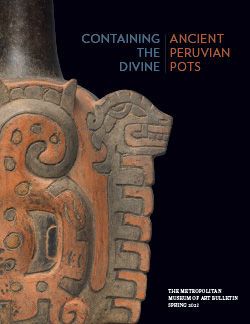Corn stalk-shaped vessel
Striking in its elegance and simplicity, this ceramic vessel was created in the shape of a corn stalk, leaves and husks removed to reveal other details of the plant. The nodes, the internodes, the aerial or brace roots, and the ears with rows of kernels, were carefully modeled and painted. The nodes on the stalk are stacked following a sinuous movement, adopting a configuration sometimes found in nature.
Normally, the corn stalk is crowned with an inflorescence or tassels. The upper end of this sculpture, however, was modeled as if the plant had been cut, and immediately below the vessel’s rim a little sprout of a new corn ear was added. Thus, this sculpture provides a view of a plant in its full vitality, the vessel’s aperture potentially allowing its contents—likely corn beer—to be revealed. Perhaps a funerary offering, the stalk is shown stunted by cutting, perhaps an allusion to the interruption of life. Yet the small sprout on top may symbolize new life, the promise of regeneration. A similar vessel can be found in the collection of the Museo Nacional de Arqueología, Antropología e Historia del Perú in Lima (Ministerio de Cultura del Perú C-54994).
Corn, also known as maize, was one of the most important ritual plants in the Andes. Fermented into beer, known as aqha or chicha, maize was an important component of celebrations throughout the Andes for hundreds of years before the rise of the Inca Empire. Corn beer is still consumed in the Andes, not only in households and at communal gatherings, but it is also offered as libations to ancestors and landscapes considered animate.
The Nasca style was the dominant artistic tradition of the South Coast of Peru during the first millennium CE. In many ways a continuation of the earlier Paracas style, Nasca artists distinguished their work through a prolific use of polychrome slips, suspensions of clay and pigments in water. In contrast to their predecessors, however, Nasca potters applied the slips before firing, permanently fixing the color to the ceramic surfaces. A brilliant sheen was achieved by burnishing the surface with a stone polisher or similar tool before firing. Fine polychrome ceramics were used in large communal ceremonies, and participants subsequently carried these prestige items home, along with the ideas they conveyed.
Hugo C. Ikehara-Tsukayama, Andrew W. Mellon Curatorial/Collection Specialist Fellow, Arts of the Ancient Americas, 2022
References and Further Reading
Cummins, Thomas B. F. Toasts of the Inca: Andean Abstraction and Colonial Images on Quero Vessels. Ann Arbor: University of Michigan Press, 2002.
Pardo, Cecilia, and Peter Fux. Nasca. Lima: Museo de Arte Lima, 2017.
Proulx, Donald A. "Paracas and Nasca: Regional Cultures on the South Coast of Peru" in Handbook of South American Archaeology, edited by Helaine Silverman and William Isbell, pp. 563-84. Springer Press, 2008.
Kevin J. Vaughn, "Craft and the Materialization of Chiefly Power in Nasca," in Foundations of Power in the Prehispanic Andes, edited by Kevin J. Vaughn, Dennis Ogburn and Christina A. Conlee. Archeological Papers of the American Anthropological Association, No. 14, pp. 113-30. American Anthropological Association, 2005.
This image cannot be enlarged, viewed at full screen, or downloaded.




